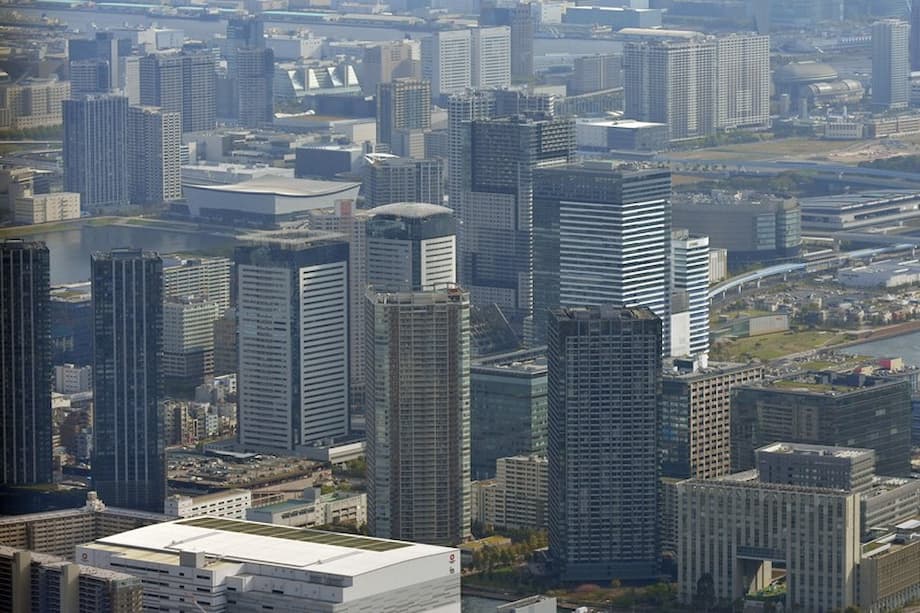Tokyo keeps growing while much of Japan shrinks
Tokyo continues to pull people, jobs, and money from across Japan at the very moment the country faces an historic slide in births. The concentration is sweeping. The Tokyo metropolitan area, which includes Tokyo, Kanagawa, Saitama, and Chiba, had about 13 percent of Japan’s population at the end of World War II. By 1970 it was 23 percent. Today it is roughly 30 percent, nearly one in three residents. Tokyo itself was the only prefecture to post population growth in the latest annual estimates, climbing around 0.34 percent year on year, while many rural prefectures shrank.
At the same time, national demographic headwinds are stiffening. Japan’s population peaked around 128 million in 2008 and fell to about 125 million by 2022. Demographic authorities project a drop to below 100 million around the mid 2050s, and to about 87 million by 2070. The fertility rate remains far below the level needed to keep population stable. The share of older residents is rising fast, and the working age population is contracting. Communities outside the capital region, where the decline is sharpest, are asking how they can sustain schools, hospitals, and local culture as their tax base shrinks and labor shortages spread.
The debate is back at the center of national politics. The new administration has promised a stronger focus on local economies and well being. Governors warn that a continued outflow of young people to the capital will accelerate decline in regions already struggling with fewer births and rapid aging. Within Tokyo, some officials worry that the capital is cast too quickly as the villain, when its economy powers much of Japan’s growth and tax revenue.
How Japan became centered on Tokyo
The postwar growth model, anchored along the Pacific Belt, supercharged Tokyo and its neighboring prefectures. The government rolled out a series of comprehensive national plans to lift regional economies with roads, rail, ports, and industrial parks. Those investments modernized the country, yet they also made the capital region an unmatched magnet for corporate headquarters, top universities, and high paying jobs. Population inflows followed, creating a self reinforcing cycle that has proven hard to reverse.
Uniform, top down approaches also had side effects. Localities were encouraged to fit a single development template. That often diluted regional identity instead of building on distinct strengths. Since 2014, a new wave of regional revitalization grants has tried to seed homegrown projects, and tax incentives have aimed to nudge companies to move jobs outside the capital region. The results are mixed. Real estate prices in Tokyo have soared, the cost of living and education remains high, yet many young people still see the capital region as the surest path to work and opportunity.
Numbers behind the shift
The Tokyo metropolitan area now holds close to 38 million people, almost 30 percent of Japan’s population. It also produces an outsized share of national output. Tokyo’s economy alone, measured by nominal gross domestic product (GDP), is estimated at more than one fifth of Japan’s total. More than half of listed company headquarters sit in the capital. These concentrations shape career pipelines, innovation networks, and capital flows that keep pulling talent toward the metropolis.
Depopulation accelerates the crisis
Japan’s demographic structure is changing at speed. Births fell below 800,000 in 2022 and are on track to decline further in coming decades. Projections suggest the population could shrink by about 30 percent between 2020 and 2070. The share of people aged 65 and older was about 29 percent in 2022 and could approach 39 percent by 2070. The working age population has fallen from roughly 68 percent in 2000 to below 60 percent and is projected to drop further. These shifts strain healthcare, pensions, education, and local services, especially outside large urban centers where distances are long and fiscal resources are thin.
Demographers project another structural change. Foreign residents, which have risen in recent years, may account for a larger share of the population by 2070. That growth could help fill some labor gaps, but it will not offset the nationwide decline. Policymakers are discussing more flexible immigration pathways, while also pushing productivity gains and higher labor participation among women and older adults. The scale of the challenge makes even ambitious measures a race against time.
Why births fell and migration flows favor the capital
Several forces push fertility down. The cost of raising children is high, which hits lower income households hardest. The rise of non regular work has widened income gaps, making family formation more difficult. Marriage rates have fallen as lifestyles and expectations shift. Housing, childcare, and work culture all influence whether young people decide to have children and where they choose to live.
Internal migration patterns add another pressure point. Tokyo’s universities and job market still draw a steady stream of high school and college graduates. The capital region offers dense networks of employers, clients, and investors, which amplifies opportunity. A record flow of international visitors in 2024 and a rise in foreign residents have also concentrated activity in and around Tokyo. These dynamics can create a loop where the capital gains more services, more jobs, and more tax revenue, while towns and small cities lose critical mass.
Is Tokyo the problem or part of the solution
Experts argue that blaming Tokyo alone misses the bigger picture. The capital region’s dense networks and scale make it a global class economic engine. Redirecting people from the metropolis to every rural prefecture is not realistic without also building competitive jobs and services elsewhere. Some researchers suggest shifting the discussion from a simple Tokyo versus rural frame toward improving life satisfaction in each region, whether urban or rural, through better jobs, housing, childcare, mobility, and community ties.
Takeshi So, a professor of urban planning at Reitaku University, has argued that the capital region’s strength is productivity, not just size. He says the policy goal should be to lift outcomes without destroying what makes the metropolis work.
This demonstrates the area’s exceptional productivity. To redistribute the population to rural areas, it is crucial to maintain current productivity levels. However, the means to achieve this remain uncertain.
The political lens is also shifting. Prime Minister Shigeru Ishiba has put regional well being on his agenda and announced new mechanisms to build local economies and living environments. In a campaign speech in Fukushima Prefecture, he framed the task in terms of civic leadership rather than national elites.
It is never the elites in the capital who change the country. It is the people in the local regions, the everyday citizens.
The megacity paradox
Research on shrinking cities in East Asia points to a loop in which national population decline and growth in a single dominant urban region feed each other. In Japan, that loop is the unipolar concentration in Tokyo. Smaller and remote cities can slip out of the usual life cycle of urban development once they lose too many people, while the central metropolis pushes up against limits in housing, transport, and affordability. Scholars describe a megacity paradox where ever larger scale brings new costs and risks for sustainability.
Tokyo’s own urban thinkers note that big cities can be tools, not just problems. With a population that is starting to decline, many solutions in Tokyo depend on small, owner driven changes rather than top down redevelopment. Converting vacant properties for community needs, and creating networks of small green spaces, are practical steps that fit fragmented ownership patterns. The lesson for the capital and for regional cities is to build resilience block by block while using technology and civic energy to close service gaps.
Why past policies fell short
Japan has tried repeatedly to balance national growth. Five rounds of nationwide plans poured funding into infrastructure and aimed to anchor people where they lived. Those projects improved connectivity but could not match the gravitational pull of Tokyo’s clustered economy. Later, decentralization assigned more tasks and discretion to municipalities. In practice, many local governments faced staffing and fiscal limits, and the strongest migration currents still pointed toward the capital.
Regional revitalization grants launched in 2014 created room for local initiative. Some prefectures and cities leveraged them well, but the nationwide population trend did not turn. Municipal mergers, which cut the number of municipalities from about 10,000 after the war to roughly 1,700 today, delivered efficiencies but also left many places with long distances to services. A single municipality often cannot maintain the full set of public facilities on its own anymore. Neighbors now need to share hospitals, cultural centers, and specialized schools through joint management and service networks.
Population policy has also focused on families. The government expanded child allowances and support for childbirth and early education, and it is exploring workplace reforms to reduce the burden of parenting. These steps are substantial and expensive. Funding them at scale is challenging in a country with high public debt. Even with stronger family policy, demographic momentum means fewer births for years ahead, so service delivery and urban form must adjust.
What regions are trying now
Some towns have started to plan for a smaller, richer future. In July, the town of Sayo in Hyogo Prefecture declared itself a shukuju town, an approach that translates as shrink and enrich. After two years of community discussion, Sayo adopted a resident driven model that asks what makes life fulfilling if the town keeps getting smaller. The population now stands near 14,000, down about 8,000 from the 2005 merger that created the current municipality. Local groups are reassessing events and services to fit a leaner future. A simple example is right sizing festivals and boosting youth participation so that traditions remain alive without overwhelming the volunteers who run them.
A town official involved in the effort explained that the idea of shrinking can sound negative, which is why engagement is central to the project.
We are just getting started. We want to broaden understanding and participation.
Other places are competing with Tokyo by building jobs and lifestyles that appeal on their own terms. Fukuoka Prefecture has invested in semiconductors, biotechnology, and startup support, while also making it easier for foreign residents to settle through one stop multilingual assistance. The region’s training programs are preparing thousands of engineers, and new hubs connect entrepreneurs to funding and mentors. Fukuoka shows how a city outside the capital can combine livability with career pathways to retain talent and attract newcomers.
Community economists argue for a multi polar map of Japan where many towns and cities become stronger nodes. They call for better internal circulation of people, goods, and money, for linking production with daily life, for mutual aid, and for redefining production to value environmental efficiency and human skills. In this view, local traditions and culture are not extras. They are assets that keep young people rooted and draw former residents back, which supports the services and small businesses that make daily life work.
Strategies that could bend the curve
No single policy will reverse demographic decline or end Tokyo’s dominance. The task is to help regions thrive with fewer people while keeping the capital productive and livable. That means investing in services that reach people where they are, shaping more compact and connected towns, and building real job ladders outside the capital region. It also means judging success by quality of life, not just headcount.
- Make remote work a permanent feature of national employment. Support satellite offices, co working hubs, and high quality digital classrooms so that career paths and education do not require a move to the capital.
- Tie corporate tax breaks to measurable job creation outside the Tokyo region. Reward firms that move core teams, not just post office boxes, and help small and medium enterprises expand into regional markets.
- Invest in fast, reliable internet for every town and village. Digital access underpins modern healthcare, education, and entrepreneurship.
- Use self driving shuttles, drone delivery, and telemedicine to bring services to elderly and remote residents. Pilot projects can start on fixed routes and expand as regulations and safety standards mature.
- Build shared service networks across neighboring municipalities. Pool hospitals, specialized schools, and cultural facilities to reach scale, with fair cost sharing.
- Adopt planning centered on public transit and walking. Concentrate housing and daily services in accessible cores, and convert excess infrastructure where populations have thinned.
- Transform vacant homes and shops into child care centers, senior day spaces, and live work units. Create simple renovation grants and one stop permit services to speed conversion.
- Make family support visible and predictable. Expand childcare slots, encourage flexible hours and remote options, and provide housing assistance for young families in regional cities.
- Welcome more foreign students, nurses, engineers, and entrepreneurs. Offer language support, credential recognition, and clear long term residency paths so communities can retain new neighbors.
- Measure what matters. Track happiness, commute times, childcare access, and social connection. Publish simple dashboards so residents can judge progress and hold leaders to account.
- Spread visitors beyond the capital. Promote regional food, nature, and culture, manage excess tourism in crowded spots, and use transport passes to nudge trips to lesser known areas.
Some of these steps cost money. Many require coordination across ministries, prefectures, and city halls. The payoff can be large. Regions that keep essential services close, build credible job options, and offer a clear path to a good life can retain more young people and attract returnees. The capital can ease pressure on housing and transport while maintaining its role as a global business center. A multi city Japan will look different from the high growth decades after the war. It can be prosperous in a new way if leaders and residents choose consistently to build for quality of life.
Highlights
- The Tokyo metropolitan area now holds about 30 percent of Japan’s population, up from 13 percent in 1945 and 23 percent in 1970.
- Tokyo was the only prefecture to grow in the latest annual estimates, while many rural prefectures shrank.
- Japan’s population could fall to about 87 million by 2070, with the share of older residents nearing 39 percent.
- Births fell below 800,000 in 2022 and are expected to decline further, keeping the fertility rate well below replacement.
- Tokyo’s economy produces more than one fifth of national GDP, and over half of listed company headquarters are in the capital.
- Tourism and a rise in foreign residents are intensifying activity in and around Tokyo, even as government policy seeks to support regions.
- Scholars describe a megacity paradox in which national decline and growth in a dominant urban region reinforce each other.
- Prime Minister Shigeru Ishiba has promised stronger focus on regional well being and local economies.
- Sayo in Hyogo Prefecture adopted a shrink and enrich approach, aiming for resident led quality of life as population falls.
- Fukuoka shows how regional cities can compete by creating jobs in advanced industries and welcoming global talent.
- Key steps include remote work, corporate incentives for regional jobs, shared services across municipalities, and planning centered on public transit.
- Success should be judged by life satisfaction, access to services, and opportunity, not only by headcount.




